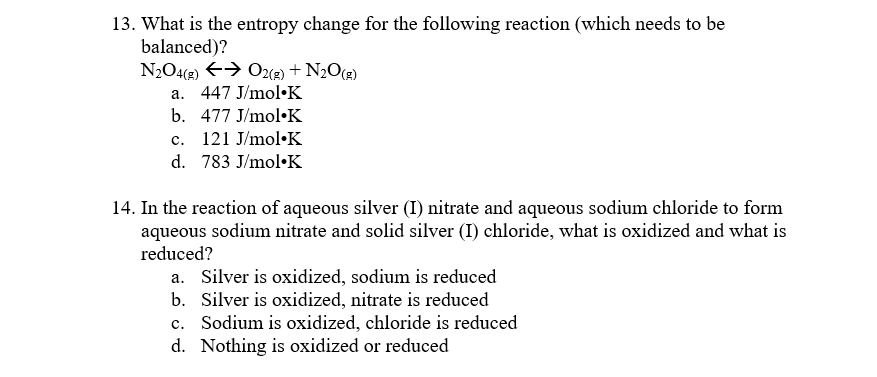13. What is the entropy change for the following reaction (which needs to be balanced)? N2O4(g) E> O2(g) + N2O(g) a. 447 J/mol•K b. 477 J/mol•K c. 121 J/mol•K d. 783 J/mol•K 14. In the reaction of aqueous silver (I) nitrate and aqueous sodium chloride to form aqueous sodium nitrate and solid silver (I) chloride, what is oxidized and what is reduced? a. Silver is oxidized, sodium is reduced b. Silver is oxidized, nitrate is reduced c. Sodium is oxidized, chloride is reduced d. Nothing is oxidized or reduced
13. What is the entropy change for the following reaction (which needs to be balanced)? N2O4(g) E> O2(g) + N2O(g) a. 447 J/mol•K b. 477 J/mol•K c. 121 J/mol•K d. 783 J/mol•K 14. In the reaction of aqueous silver (I) nitrate and aqueous sodium chloride to form aqueous sodium nitrate and solid silver (I) chloride, what is oxidized and what is reduced? a. Silver is oxidized, sodium is reduced b. Silver is oxidized, nitrate is reduced c. Sodium is oxidized, chloride is reduced d. Nothing is oxidized or reduced
Chemistry & Chemical Reactivity
9th Edition
ISBN:9781133949640
Author:John C. Kotz, Paul M. Treichel, John Townsend, David Treichel
Publisher:John C. Kotz, Paul M. Treichel, John Townsend, David Treichel
Chapter18: Principles Of Chemical Reactivity: Entropy And Free Energy
Section: Chapter Questions
Problem 32PS
Related questions
Question
You don't have to go into detail because I already know how to do it but would like to verify the questions. Please just clarify which option is the correct one.

Transcribed Image Text:13. What is the entropy change for the following reaction (which needs to be
balanced)?
N2O4(2) E> O2(2) + N2O(2)
a. 447 J/mol•K
b. 477 J/mol•K
c. 121 J/mol•K
d. 783 J/mol•K
14. In the reaction of aqueous silver (I) nitrate and aqueous sodium chloride to form
aqueous sodium nitrate and solid silver (I) chloride, what is oxidized and what is
reduced?
a. Silver is oxidized, sodium is reduced
b. Silver is oxidized, nitrate is reduced
c. Sodium is oxidized, chloride is reduced
d. Nothing is oxidized or reduced
Expert Solution
This question has been solved!
Explore an expertly crafted, step-by-step solution for a thorough understanding of key concepts.
This is a popular solution!
Trending now
This is a popular solution!
Step by step
Solved in 2 steps with 2 images

Knowledge Booster
Learn more about
Need a deep-dive on the concept behind this application? Look no further. Learn more about this topic, chemistry and related others by exploring similar questions and additional content below.Recommended textbooks for you

Chemistry & Chemical Reactivity
Chemistry
ISBN:
9781133949640
Author:
John C. Kotz, Paul M. Treichel, John Townsend, David Treichel
Publisher:
Cengage Learning

Chemistry & Chemical Reactivity
Chemistry
ISBN:
9781337399074
Author:
John C. Kotz, Paul M. Treichel, John Townsend, David Treichel
Publisher:
Cengage Learning

Chemistry: Principles and Practice
Chemistry
ISBN:
9780534420123
Author:
Daniel L. Reger, Scott R. Goode, David W. Ball, Edward Mercer
Publisher:
Cengage Learning

Chemistry & Chemical Reactivity
Chemistry
ISBN:
9781133949640
Author:
John C. Kotz, Paul M. Treichel, John Townsend, David Treichel
Publisher:
Cengage Learning

Chemistry & Chemical Reactivity
Chemistry
ISBN:
9781337399074
Author:
John C. Kotz, Paul M. Treichel, John Townsend, David Treichel
Publisher:
Cengage Learning

Chemistry: Principles and Practice
Chemistry
ISBN:
9780534420123
Author:
Daniel L. Reger, Scott R. Goode, David W. Ball, Edward Mercer
Publisher:
Cengage Learning


Chemistry
Chemistry
ISBN:
9781305957404
Author:
Steven S. Zumdahl, Susan A. Zumdahl, Donald J. DeCoste
Publisher:
Cengage Learning

Chemistry: An Atoms First Approach
Chemistry
ISBN:
9781305079243
Author:
Steven S. Zumdahl, Susan A. Zumdahl
Publisher:
Cengage Learning